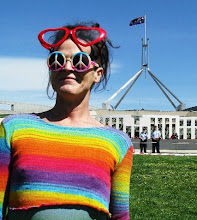My local newspaper
Here's a wee article about the folk of my local church who put out the local newspaper and their commitment to social jsutice activism. It's sometimes obvious that I am well in the Flow, knowing and working with these people. Dorothy in particular, who was supportive during my recent struggle with gender normativity (discussed currently on my more intimate blog, http://eunuchlove.blogspot.com/)
The following story is written by Erin J. Tennant and seems to have been published only just today (how's that for timing and coincidence! I just happened upon it when googling for Vlad's email address!)
http://insights.uca.org.au/ministryprofiles/m-z/
sthsydneyherald.htm
The fun of interviewing a fellow reporter (or three of them at once) is how little following-up is needed.
You shoot a not especially probing question onto the table (such as, “You must meet a lot of people running a community rag, eh?”) and sit back as your interviewees (in this case, the managing editor and two editorial staff from The South Sydney Herald) lob the issue back and forth, weigh in with quotable apercus and, with little prompting, shift the discussion onto more specific matters that you realise would have been smart to ask about in the first place; such as the labour of love these South Sydney Uniting Church congregation members undergo in providing community service journalism to their area, the hurdles of attracting advertisers to their 16-page tabloid, coordinating dozens of stories from staff and contributors each month using mainly home computers, supplying free monthly circulation to ten inner-Sydney suburbs via a collection of volunteers, or the ongoing effort at building a community profile and sourcing valuable contacts — and all the while backing up their expositions with colourful anecdotes.
Quotes, details, background, colour. Story done.
Yet combining missional work with journalism is a tricky game, particularly if you want the trust of a predominantly secular readership.
“I’m very sensitive that we don’t abuse our power,” explains Vladimir Korotkov, editor of the Herald and minister at the South Sydney congregation. “The stories come naturally, rather than our strategically thinking how can we put a message in there somehow.
“What [my colleagues] agree on is that God is involved in this community and we’re just cooperating with this unseen work of God. It’s like Jeremiah 29: ‘Seek the welfare of the city in which you live ... Pray for it, for its welfare is your welfare.’”
God’s work may be unseen here, but the Herald, circulating since 2000, is holding an increasingly visible presence in the lives of inner Sydney residents, with 17,000 copies distributed each month from Surry Hills to Newtown.
And while their attitude may appear casual (editorial meetings are held at a local coffee shop in Redfern, where Insights caught up with Vladimir and colleagues Dorothy McRae-McMahon, a retired minister and former director of the national Commission for Mission, and Trevor Davies, a long-time resident activist and congregation member) the editorial team assure me the Herald is no slack operation.
Vladimir’s church office is set up with computer, printer and scanner, with broadband internet and fax machine. Trevor and Dorothy do their editorial part from home, staff photographer Ali Blogg supplies the pictures and the remaining editorial content comes via contributors.
Copy is sent to designers in Surry Hills, re-proofed, relayed to printers in Marrickville, and then distributed to homes and selected businesses (by church volunteers).
A glance at recent front-cover stories reveals the tone of the Herald’s journalism: a Cambodian business owner establishes a new life in Australia as a Redfern baker after witnessing the terrors of the Khmer Rouge (July issue); a Redfern policing program fails to address Aboriginal issues (August issue); the local council’s Homeless Persons Information Centre celebrates its 20th anniversary (October issue).
There is also a regular faith column that appears within the editorial or as a separate op-ed.
“We cover the poorest suburbs with incredible problems — we’re not going for the sexy headline,” says Trevor.
“We also reach out to those more upwardly mobile who have needs as well,” he adds, citing a recent story on changes to strata title laws affecting Surry Hills residents.
Vladimir: “We’ve been criticised as a Labor rag, but we do attempt to provide a broad perspective of people who represent different political positions. We have a real commitment to core issues which are sliding out of government interests and out of mainstream media’s interests, such as Aboriginal issues, multicultural issues, support for gay and lesbians, and women’s rights.”
Dorothy: “When we see something good and creative and encouraging, when we see a person in the area who’s done a good job over a long time, we tell that story.”
There are certain issues the Herald will shy away from, however, such as stories depicting the deep divisions within the local Aboriginal community. “That kind of story will just perpetuate the stereotypical understanding of Aboriginal people — I just don’t think it adds value,” says Vladimir.
“The sort of people we want to chase down are politicians; the people who wield power,” says Trevor.
It is a formula that seems to be working, with the inner-Sydney tabloid gaining a level of trust among readers that has drawn new attendees to Sunday sermons.
Dorothy: “This [newspaper] is about genuinely loving a raw, struggling community with all its laughs and tears. We are a part of it, rather than observing it.”
Erin J. Tennant
The following story is written by Erin J. Tennant and seems to have been published only just today (how's that for timing and coincidence! I just happened upon it when googling for Vlad's email address!)
http://insights.uca.org.au/ministryprofiles/m-z/
sthsydneyherald.htm
Missional journos serve secular readers
The fun of interviewing a fellow reporter (or three of them at once) is how little following-up is needed.
You shoot a not especially probing question onto the table (such as, “You must meet a lot of people running a community rag, eh?”) and sit back as your interviewees (in this case, the managing editor and two editorial staff from The South Sydney Herald) lob the issue back and forth, weigh in with quotable apercus and, with little prompting, shift the discussion onto more specific matters that you realise would have been smart to ask about in the first place; such as the labour of love these South Sydney Uniting Church congregation members undergo in providing community service journalism to their area, the hurdles of attracting advertisers to their 16-page tabloid, coordinating dozens of stories from staff and contributors each month using mainly home computers, supplying free monthly circulation to ten inner-Sydney suburbs via a collection of volunteers, or the ongoing effort at building a community profile and sourcing valuable contacts — and all the while backing up their expositions with colourful anecdotes.
Quotes, details, background, colour. Story done.
Yet combining missional work with journalism is a tricky game, particularly if you want the trust of a predominantly secular readership.
“I’m very sensitive that we don’t abuse our power,” explains Vladimir Korotkov, editor of the Herald and minister at the South Sydney congregation. “The stories come naturally, rather than our strategically thinking how can we put a message in there somehow.
“What [my colleagues] agree on is that God is involved in this community and we’re just cooperating with this unseen work of God. It’s like Jeremiah 29: ‘Seek the welfare of the city in which you live ... Pray for it, for its welfare is your welfare.’”
God’s work may be unseen here, but the Herald, circulating since 2000, is holding an increasingly visible presence in the lives of inner Sydney residents, with 17,000 copies distributed each month from Surry Hills to Newtown.
And while their attitude may appear casual (editorial meetings are held at a local coffee shop in Redfern, where Insights caught up with Vladimir and colleagues Dorothy McRae-McMahon, a retired minister and former director of the national Commission for Mission, and Trevor Davies, a long-time resident activist and congregation member) the editorial team assure me the Herald is no slack operation.
Vladimir’s church office is set up with computer, printer and scanner, with broadband internet and fax machine. Trevor and Dorothy do their editorial part from home, staff photographer Ali Blogg supplies the pictures and the remaining editorial content comes via contributors.
Copy is sent to designers in Surry Hills, re-proofed, relayed to printers in Marrickville, and then distributed to homes and selected businesses (by church volunteers).
A glance at recent front-cover stories reveals the tone of the Herald’s journalism: a Cambodian business owner establishes a new life in Australia as a Redfern baker after witnessing the terrors of the Khmer Rouge (July issue); a Redfern policing program fails to address Aboriginal issues (August issue); the local council’s Homeless Persons Information Centre celebrates its 20th anniversary (October issue).
There is also a regular faith column that appears within the editorial or as a separate op-ed.
“We cover the poorest suburbs with incredible problems — we’re not going for the sexy headline,” says Trevor.
“We also reach out to those more upwardly mobile who have needs as well,” he adds, citing a recent story on changes to strata title laws affecting Surry Hills residents.
Vladimir: “We’ve been criticised as a Labor rag, but we do attempt to provide a broad perspective of people who represent different political positions. We have a real commitment to core issues which are sliding out of government interests and out of mainstream media’s interests, such as Aboriginal issues, multicultural issues, support for gay and lesbians, and women’s rights.”
Dorothy: “When we see something good and creative and encouraging, when we see a person in the area who’s done a good job over a long time, we tell that story.”
There are certain issues the Herald will shy away from, however, such as stories depicting the deep divisions within the local Aboriginal community. “That kind of story will just perpetuate the stereotypical understanding of Aboriginal people — I just don’t think it adds value,” says Vladimir.
“The sort of people we want to chase down are politicians; the people who wield power,” says Trevor.
It is a formula that seems to be working, with the inner-Sydney tabloid gaining a level of trust among readers that has drawn new attendees to Sunday sermons.
Dorothy: “This [newspaper] is about genuinely loving a raw, struggling community with all its laughs and tears. We are a part of it, rather than observing it.”
Erin J. Tennant


0 Comments:
Post a Comment
<< Home